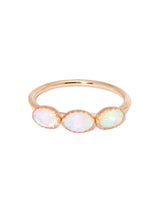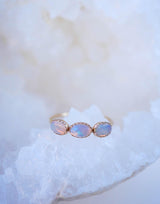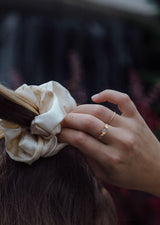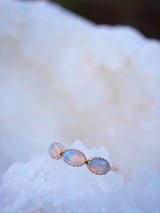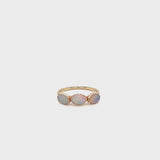Opal Halo Ring
Trio of Australian opals set in 14k gold serrated bezel settings atop a 10k solid gold band.
Kindly Note: Due to the nature of the stones, color and flash may vary slightly. This piece is made to order, so please allow up to two weeks for fabrication.

Solid Gold:
Gold Filled:
Layers of solid 14k gold are pressure bonded to a core of either sterling silver or jeweler’s brass. The result is a durable, price-friendly alternative to solid gold, with over 100 times more gold in it than gold plated pieces. It remains nickel free, hypoallergenic and can get wet without tarnishing or turning your skin green.
Gold Plated:
A thin layer of gold electrically deposited onto a surface via electroplating. With direct contact to your skin, this will eventually wear off. Luckily, the only base metal pieces we offer do not directly touch your skin. (The Folded Fans for example have 14k gold filled ear wires).
Gold Plating on Top of Gold Fill:
For some of our fabricated gold filled pieces such as bezel-set rings, we add another layer of 14k gold via electroplating. Why? Heavily fabricated pieces need to be sanded and polished, which results in removing some of the layer of gold in the gold fill. By plating on a top coat, it ensures that the gold isn’t thin at the soldering joints, and evens and smooths the sanded areas / seams.
Sterling Silver:
We also use sterling silver! Silver is the softest out of these metals but still great for everyday wear. Silver can tarnish when exposed to moisture or humidity whereas gold will not.
Jewelry Care:
General:
Although certain metals can get wet and do not tarnish if they are properly dried, cared for and stored, we do NOT recommend showering in, sleeping in, spraying perfume or applying lotions / makeup directly on or near EWD jewelry. Overtime, these activities can dull, wear out, weaken, and warp your pieces. For best outcome, store your pieces of jewelry separately to prevent them from scratching each other, or store in a jewelry box / case to protect them from moisture. To prolong sterling silver from tarnishing, store in sealed plastic baggies with tarnish paper inside.
A few other tips:
- Remove jewelry before doing the dishes, working out, gardening, using harsh cleaning products, using alcohol and acetone based products, swimming, or using hand sanitizer.
- Avoid swimming in salt water or chlorine because these chemically react with the alloys in gold causing corrosion, discoloration, and decreased structural integrity.
We are not responsible for compensating repairs if the piece breaks by force (i.e. dropping or bumping into something, snagging on clothing, lifting weights, etc.) or due to the aforementioned activities. Our pieces are delicate but well made, and will last a lifetime if cared for correctly!
EWD Cleaning Solution:
Our cleaning solution is good for all metal types and most stones. However, we do not suggest soaking your opals, alexandrites, or pearls in the solution. (Available here)
For all metal types (including plated jewelry):
Wash with warm water + gentle dish soap and a soft bristled toothbrush. Soak the piece in warm soapy water for 5 minutes or so before scrubbing built up dirt and debris off. Dry thoroughly with a soft cloth.
Jewelry Polishing Cloth:
This is a special polishing cloth or pad with a polishing compound embedded in its fibers. It can be used on gold, sterling silver, and gold filled but is not recommended for plated jewelry (it will “polish” the layer of plating right off). We recommend the Sunshine Polishing Cloth or can provide you with one of our own in store.
Stone Care:
Most stones do just fine in our cleaning solution and will shine them up to the most sparkly you’ve ever seen them!
ABOUT NATURAL DIAMONDS:
We source the highest quality stones possible in the industry from artisan gemstone cutters to certified diamond distributors. All of our purveyors follow Kimberly Process guidelines, guaranteeing responsible sourcing channels, higher standards for mining, labor and cutting practices. One of our partners, Misfit Diamonds, sources diamonds with 100% traceable origin and documented provenance straight to the mine - something extremely hard to come by in the current diamond market.
Unlike lab formed counterparts, Natural diamonds retain (and often increase in) their value over time, making them a smart long term investment.
Because they are formed by the earth, there is a wider range of shapes, cuts, and colors / variations while lab diamonds are only available in specific standard sizes and shapes.
ABOUT LAB DIAMONDS:
Lab-grown diamonds test as and are considered genuine diamonds — not simulants. They are optically, visually, and chemically identical to natural diamonds.
Instead of forming over millions of years in the earth's mantle, they are created in rough crystal form by scientists using a fragment of a natural diamond or "diamond seed." Although they are considered an ethical option, they do still require mining the properties (phosphorous & carbon) and the use of electricity and water to complete the process.
Lab formed diamonds are an attractive price alternative but do not hold their value longterm like natural diamonds do. Something to keep in mind is that they have little to no resale value once purchased.


ABOUT MOISSANITE:
Moissanite is a naturally occurring mineral composed of silica carbide that scientists have recreated in a lab. Its chemical and optical properties cause it to radiate unparalleled fire and brilliance, making it one of the most durable yet affordable gemstones available today.
The Physical Properties of Moissanite:
The brilliance and fire of moissanite rank higher than a diamond, making it refract more of a rainbow-like effect than diamonds. The hardness ranks second to a diamond, making it a very durable option.
Disclaimers about Moissanite:
Although mainstream research presents moissanite as a "second diamond" alternative, the way that it is created causes porosity within the stone's surface. Although it is hard like a diamond if it were to come in contact with another hard surface and not break, it can have chemical reactions with household cleaning products (bleach, acetone, even hand sanitizer), lotions / oils, other chemicals and even build-up over time which can cause the stone to turn cloudy or discolor if not cared for properly.
Because of this, we would recommend diamond over moissanite for everyday wear.
The discoloration of a moissanite due to these outside factors is unfortunately not reversible, and we are not held responsible for any damages if this is to occur.
Opal Care:
Most of the opals used in the Classic Collection listed as “confetti” or “white” opals are cultured, therefore they are stronger and will not absorb liquid or change colors. Those are just fine to go in the jewelry cleaning solution and can be cleaned with soap and water as well.
Australian and Ethiopian opals should be cared for separately. A general rule of thumb to keep in mind is that their hardness is about that of glass (6.5 on Mohs hardness scale) therefore you should remove it when doing anything too hands on to avoid scratching or breaking it.
Australian opal is a soft mineral composed of silicon and water that forms when silica-rich water crystalizes when trapped in rock (sediment) over thousands of years. It has incredible arrays of light and color and each one is unique. It is safe to use gentle dish soap with warm water and a soft brush to clean. Dry thoroughly with a cloth.
Ethiopian opals are different from Australian opals because they come from volcanic deposits rather than sedimentary deposits. Ethiopian opal is hydrophane (from the Greek meaning “water loving”) and absorbs liquids. Because of this, the stone can absorb liquids that will damage its color properties; any pure water it absorbs should dry in a day or two without damaging the stone. Be aware that oils, soaps and chemicals if absorbed, may stain the stone, changing its color or damaging its signature play of light. Clean the stone with a soft cloth. Never clean using soap, chemicals, oil, steam or ultrasonics. Kindly note: Although it is likely to regain its original color when only exposed to water itself, sometimes it can look slightly different than before or look matte, which is why we suggest avoiding water to be safe. To clean the stone, simply wipe with a dry cloth. To clean its setting, we’d recommend the metal polishing cloth route!
Below is an example of a hydrophane opal when exposed to the above listed contaminants:


